Xinjiang—China’s largest province—literally translates to “new domain.” It is viewed as so because the region is an isolated area along the northwestern borders of China that is largely inhabited by ethnicities that remotely resemble the Han. In 2001, following the 9/11 attacks in the United States of America (USA), the People’s Republic of China (PRC) declared that it, too, was suffering from terrorism. The Uyghurs are a large Sunni Muslim population in Xinjiang that the PRC has classified as a terrorist group. Although there is speculation about Uyghur ties with al-Qaeda and/or Russia, China’s classification seems to justify any repression to the separatism, or denial of conformity, to the outside world. It is highly probable that the reason for Chinese oppression is closely related to the location of the region and its trade routes to the north and northwest. But, it seems that the battle from the indigenous population’s perspective is closely related to a struggle for sovereignty.
Xinjiang is China’s largest province (640,930 square miles or 1,660,000 square kilometers) and is a strategically important economic trade route that has limited accessibility because of its terrain. It borders Kazakhstan, Mongolia, Kyrgyzstan, Tajikistan, Afghanistan, Pakistan, Aksai Chin, and Kashmir. It consists of five regions: Junggar (Dzungarian) Basin, Tien (Tian) Shan Mountains (central, between the Junggar Basin and Tarim Basin), the Tarim Basin, and the Kunlun Mountains. Creating a natural barrier from the south and the north, the Altai Mountains (semi-circle along the Mongolian border) along with the Tien Shan Mountains (stretching from east to west in the southern part of the region) limit accessibility to China’s neighboring nations. Therefore, to increase trade from China’s eastern side toward Kazakhstan, Mongolia, Russia, and the other countries to the west and north, the PRC must pass through the Uyghur-dominated Xinjiang. In addition, Xinjiang has many mines that provide needed resources, such as coal.
The Chinese government officially recognizes 56 ethnic groups, over 40 of which reside in the Xinjiang region. With a population of approximately 1.326 billion people, China is 91.6 percent Han Chinese, 1.3 percent Zhuang, and 7.1 percent other (including Hui, Manchu, Uyghur), the dominant of which in the Xinjiang region are: Uyghurs (Sunni Muslim; approximately 8,823,500), Han (Chinese), Hui (Chinese Muslims; approximately 866,700), Mongolians (approximately 166,900), Khalkha, Kzakhs, Usbeks (Sunnite Muslim), Manchu (approximately 23,900), Tajiks (predominantly Sunni Muslim, some are Shi’ite), Tatars (partially Sunnite Muslim), Russians, and Tahurs. Out of these groups, the Uyghur is the dominant force in Xinjiang.
The Uyghur is an indigenous population to the land of Xinjiang, but they do not resemble the Han Chinese. In fact, they are a Muslim culture that practices Sunni. In the 1940s, the Han Chinese entered the Xinjiang region and began to exploit the area for its natural advantages and resources: trade routes and mineral deposits. In the mid 1950s, the Xinjiang Production and Construction Corps began to dominate the market. With increased business came an influx of millions of Han Chinese soldiers and civilians. Just as previous occupations have done, the Han dominated the area and changed the culture to fit the Han’s ideology. The Chinese did not recognize the practice of Islam, the identity of Muslims, and did not care for a shared language, ethnicity, history, or divergent cultural practices. Therefore, the same belittlement that the Uyghur population endures can be correlated to other examples of repression, like the Algerians under French colonization. In like manner they, too, rebel. Since their identity has been repressed, the Uyghur people fight back against the Han, in what the Chinese government calls terrorist separatist rebellion. Due to the location it is hard for the rebellion to obtain a large amount of weaponry. Therefore, most of the tactics used tend to resemble other terrorist organizations (i.e., explosives). Ultimately, the Chinese claim Xinjiang as a portion of China, even though the indigenous inhabitants of the region do not consider themselves Chinese.

China has an increased interest in the region because of the new construction of the One Belt, One Road (OBOR) initiative. In 2013, Chinese President Xi Jingping unveiled China’s OBOR initiative in Kazakhstan with the following goals: strengthen policy communications, improve road connectivity, promote trade, enhance the circulation of money, and strengthen people-to-people exchanges throughout Eurasia. Through this goal, China aims to dominate economy and increase trade. Because of the mountainous terrain and importance to the OBOR, China aims to complete construction through the Uyghur-dominated Xinjiang. Additionally, China aims to increase its global domestic product (GDP) through the modern Silk Road and wipe out competition with other economies (i.e., India, Russia, or any sub-state actor). For this reason, the PRC will most likely increase pressure on the Uyghur, or any other ethnic group that stands in opposition. Because of this increased oppression, it is likely that the Uyghur will ally with external forces.
It is clear that Xinjiang is key terrain for the PRC’s goals. However, it is also clear that a non-conformist substate actor that obstructs China, like the Uyghurs in the region, will become an increased target. External links and influences may also play a role. It is probable that trade will increase whether the Han dominate the region or not. But, the funds that will be generated through the trade route will end up financing the dominant force in the region, regardless of which that may be. Therefore, if al-Qaeda or Russia have an increased presence, then regional funds will bolster China’s opposition. Ideologically, the Uyghurs do not follow the Han. However, the Han cannot commit genocide without the United Nations (UN) and the world noticing. Much like the other forms of oppression, and lack of recognition, the Uyghurs will rebel, and others will join their cause.
















